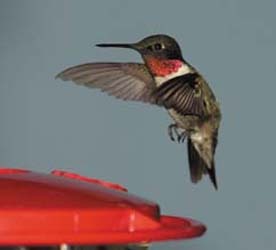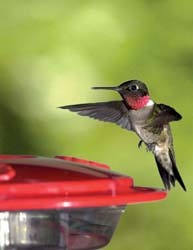Ruby-throated Hummingbirds
Ruby-throated Hummingbird


Cool Facts:
- The Ruby-throated Hummingbird beats its wings about 53 times a second.
- The extremely short legs of the Ruby-throated Hummingbird prevent it from walking or hopping. The best it can do is shuffle along a perch. Nevertheless, it scratches its head and neck by raising its foot up and over its wing.
- Ruby-throated Hummingbirds prefer to feed on red or orange flowers (though it's not necessary to color the sugar water you put in a hummingbird feeder). Like many birds, hummingbirds have good color vision and can see into the ultraviolet spectrum, which humans can’t see.
- Ruby-throated Hummingbirds normally place their nest on a branch of a deciduous or coniferous tree; however, these birds are accustomed to human habitation and have been known to nest on loops of chain, wire, and extension cords.
- Ruby-throated Hummingbirds are eastern North America’s only breeding hummingbird. But in terms of area, this species occupies the largest breeding range of any North American hummingbird.
- Male Ruby-throated Hummingbirds don’t stick around long. Pairs are together long enough for courtship and mating – just a matter of days to weeks. Then he’s off on his own, and may begin migration by early August.
- The oldest known Ruby-throated Hummingbird was a female, and at least 9 years, 1 month old when she was recaptured and re-released during banding operations in West Virginia.
- Ruby-throated Hummingbirds feed on the nectar of red or orange tubular flowers such as trumpet creeper, cardinal flower, honeysuckle, jewelweed, bee-balm, red buckeye and red morning glory, as well as at hummingbird feeders and, sometimes, tree sap. Hummingbirds also catch insects in midair or pull them out of spider webs. Main insect prey includes mosquitoes, gnats, fruit flies, and small bees; also eats spiders. Ruby-throated Hummingbirds sometimes take insects attracted to sap wells or picks small caterpillars and aphids from leaves.
Nectar Recipe:
1.) Mix 1 part table sugar with 4 parts water and bring to a boil to kill any bacteria or mold present
2.) Cool mixture and fill feeder
3.) Extra sugar water may be stored in a refrigerator
*Red dye should not be added*
Change the water before it grows cloudy or discolored and remember that during hot weather, sugar water ferments rapidly to produce toxic alcohol.

